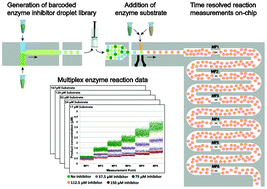Enzyme kinetics and inhibition is important for a wide range of disciplines including pharmacology, medicine and industrial bioprocess technology. We present a novel microdroplet-based device for extensive characterization of the reaction kinetics of enzyme substrate inhibitor systems in a single experiment utilizing an integrated droplet picoinjector for bioanalysis. This device enables the scanning of multiple fluorescently-barcoded inhibitor concentrations and substrate conditions in a single, highly time-resolved experiment yielding the Michaelis constant (Km), the turnover number (kcat) and the enzyme inhibitor dissociation constants (ki, ki′). Using this device we determine Km and kcat for β-galactosidase and the fluorogenic substrate Resorufin β-D-galactopyranoside (RBG) to be 442 μM and 1070 s−1, respectively. Furthermore, we examine the inhibitory effects of isopropyl-β-D-thiogalactopyranoside (IPTG) on β-galactosidase. This system has a number of potential applications, for example it could be used to screen inhibitors to pharmaceutically relevant enzymes and to characterize engineered enzyme variants for biofuels production, in both cases acquiring detailed information about the enzyme catalysis and enzyme inhibitor interaction at high throughput and low cost.

You have access to this article
 Please wait while we load your content...
Something went wrong. Try again?
Please wait while we load your content...
Something went wrong. Try again?


 Please wait while we load your content...
Please wait while we load your content...